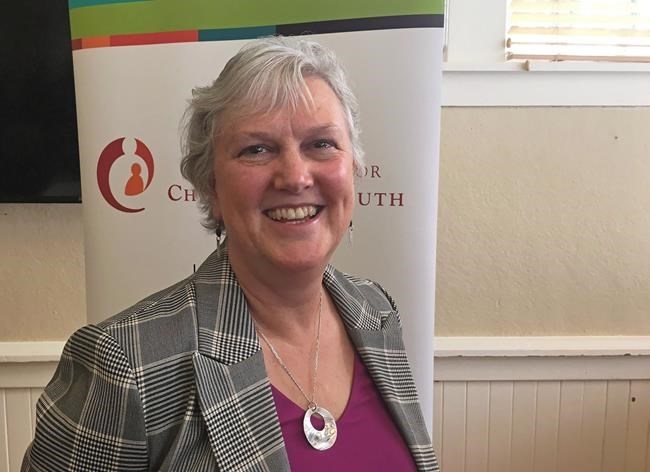
British Columbia's Representative for Children and Youth Jennifer Charlesworth is seen in Victoria on Monday, Dec. 10, 2018. A new report has found that the number of young offenders in British Columbia has "dramatically decreased," putting the ratio of staff to youth in custody at almost 11-to-one. THE CANADIAN PRESS/Dirk Meissner
Republished January 25, 2024 - 5:56 PM
Original Publication Date January 25, 2024 - 12:46 PM
VICTORIA - The number of incarcerated young offenders in British Columbia has fallen so dramatically that the province needs to come up with a plan to reallocate resources to avoid waste, a report released Thursday says.
The report from the office of Jennifer Charlesworth, B.C.'s representative for children and youth, says the average daily number of youth in custody in the province has fallen from 386 in 1997/1998 to as low as 11 in 2021/2022.
The "dramatically decreased" figures meant there were 11 staff for every youth in custody at dedicated facilities.
"So, what is called for here is a redeployment of excess capacity in the youth justice system to other areas that are desperately wanting," Charlesworth said at a news conference announcing the results. "And there's no shortage of those.
"The next question becomes, how might that be done? That is, how should surplus resources be reallocated?"
The report, titled Missed Opportunities, highlighted what Charlesworth called a sharp contrast between resources dedicated by B.C.'s Ministry of Children and Family Development to youth justice and "urgent under-resourcing" in other services provided by the ministry.
Results from the report showed that the average community youth justice caseload, or cases supervised by probation officers, sat at 808 in 2022/2023 — less than one-fifth of the 4,150 recorded in 2000/2001.
That is also reflected in the number of Indigenous youth in custody, with figures falling from 95 in 1998/1999 to six in 2021/2022.
The report attributed the drop to several factors ranging from a "marked decrease" in youth crime in the province, the integration of community youth justice and custody services, enhanced federal funding and rules limiting pretrial detention changed by the Youth Criminal Justice Act in 2003.
Minister of Children and Family Development Grace Lore said in a statement her office was reviewing the recommendations, particularly about redeploying resources.
She said the report underlined some "important and positive trends," such as the province's per-capita rate of youths in custody being the lowest in the country, and declines in youth crime rates.
Lore said she agreed that spending and resources for youth should reflect "changing realities," in particular the needs of Indigenous youth.
Youth justice researcher Alan Markwart authored the report and said the province’s two youth custody centres in Burnaby and Prince George last year had a staffed capacity for 108 youths, but they held 15.
"That level of staffing is completely unnecessary," Markwart said. "It's surplus staffing. The occupancy last year was 14 per cent of staffed capacity."
The province is planning to close the youth custody centre in Prince George at the end of March, but Charlesworth said that could create new problems, such as young offenders from northern B.C. being placed far from their family in Burnaby.
She said the closure decision was made without consulting groups such as the First Nations Justice Council, local Indigenous communities, the Métis Nation and the BC General Employees' Union.
Charlesworth said there were no announced plans on how the funds and resources for the centre would be reallocated.
"I want to be clear that I'm not suggesting a cut in funding in services to children and youth, absolutely not," she said. "And while I understand what the thinking was behind the province's decision to close the Prince George Youth Custody Centre, I do have some concerns."
The report said the province should look at retaining a six-bed temporary detention facility in Prince George for possibly housing young offenders in custody when needed.
It also recommended that more engagement with Indigenous groups and local communities should take place to decide how to use the resources being shifted from youth custody centres.
Charlesworth said many of the staff in youth justice are skilled in other areas of need such as mental health, and the suggested reallocations would be a logical deployment of resources.
She said it may also benefit the province to look at funding "individually tailored" services, targeting youth in northern areas to avoid the need for custody in the first place.
"It's not often we find surplus of government funding directed at one area," Charlesworth said. "But we have here a situation that needs correcting, or perhaps it's more accurate to say that government has a golden opportunity to improve services for children and youth who urgently need it."
— By Chuck Chiang in Vancouver
This report by The Canadian Press was first published on Jan. 25, 2024.
News from © The Canadian Press, 2024